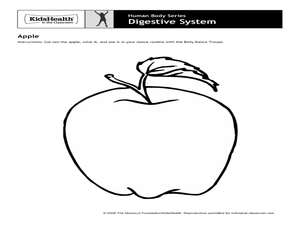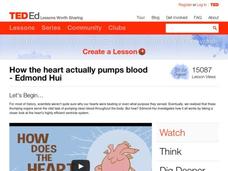TED-Ed
Why Are Human Bodies Asymmetrical?
Did you know that your lungs are asymmetrical? Yep, the left lung has two lobes and the right has three. Buy why? Check out this video on the asymmetrical features of the human body.
Curated OER
Human Body Series - Bones, Muscles, and Joints
Strengthen understanding of the musculoskeletal system with a structured lesson! Begin with a discussion of bones, joints, and muscles. Have small groups read assigned articles and watch videos to gather information and then write a...
TED-Ed
Gravity and the Human Body
How does the absence of gravity affect the human body? The skeletal system, circulatory system, and the sense of balance are all impacted. With a very casual tone, an astronaut explains the changes to these body systems and also an...
TED-Ed
How Does Cancer Spread Through the Body?
Cancer's ability to quickly spread from one organ to the next makes it one of the most fatal diseases in recent history. Watch as this short video takes you on a trip into the microscopic world of cancer cells, exploring the...
Amoeba Sisters
Human Body Systems: The 11 Champions
An informative video offers a brief overview of the 11 systems in the human body. It gives a brief description of each before pointing out their interdependence.
Curated OER
Human Body Series - Digestive System
With articles entitled, "What's Puke?" and "What is a Fart?" this digestive system lesson is sure to be a gas! Elementary anatomists do a belly dance to illustrate how food moves through the digestive system and then design a board game...
Curated OER
Human Body Series - Cardiovascular System
Pump up your class while studying the cardiovascular system with this pair of activities. In one, learners record heart rates during different actions. In the second, they read kid-friendly heart health articles online and then write a...
Early Childhood Learning and Knowlege Center
My Body My Senses
In a comprehensive unit of activities, learners explore the five senses. Youngsters discover the many different body parts and their functions that allow humans to have sense of sight, touch, smell, taste, and hearing. The best way to...
Crash Course
The New Anatomy: Crash Course History of Science #15
How did scientists move beyond the medical ideas of Galen? Dissect the past with the 15th installment in a History of Science video series. Topics include Vesalius' dissections, the microscope, and mapping the human body.
TED-Ed
The Evolution of the Human Eye
Vision is arguably the most important of the five senses, but exactly how did we come by this amazing ability? Find out with this engaging video on the 500 million year evolution of the human eye.
PBS
Seasonal Science: Frostbite
Fingers, toes, and nose. Oh, my! It's so cold outside. An animated video models the four-step progression of frostbite and how it affects the human body.
Curated OER
Human Ancestry Made Easy
Explore the Out of Africa Theory, genetics, and human ancestry with this clear and interesting video clip. Older scientists will gain a basic understanding of how genetic markers have helped anthropologists determine the origin and...
Veritasium
Can Humans Sense Magnetic Fields?
It is true that Earth has a magnetic field, but do human bodies detect it? Part of a larger series, an interesting video lesson describes an experiment that attempts to answer the question. Using brain scans while exposed to a simulation...
TED-Ed
Oxygen’s Surprisingly Complex Journey Through Your Body
What does digestion have to do with aerobic respiration? Watch a video that explains the processes and systems in our bodies that allow oxygen to travel throughout.
TED-Ed
How a Wound Heals Itself
Did you know that the biggest organ in the human body isn't the brain, the liver, or even the lungs? It's the skin. Follow along with this short video as it explores the structure of human skin and its amazing ability to...
SciShow
What Happens if Your Body is Exposed to the Vacuum of Space?
What might happen if a body encounters the vacuum of space? Through multiple experiments and a couple of real-life accidents, we know more about how a person would die — and it doesn't look nearly as dramatic as science fiction...
Be Smart
The Recipe For Life…
The narrator of a short video explores carbon and why it is the basis for all life on Earth and discusses all elements necessary for life that can be found in the human body.
FuseSchool
Human Defense Systems Against Pathogens
With so many harmful agents around us, how do humans stay healthy? Find out by watching an informative video from a larger biology playlist that details our defenses against a variety of pathogens. The narrator describes the body...
TED-Ed
Why Do Humans Have a Third Eyelid?
That little pink bud in the inside corner of your eye is actually a vestigial eyelid! Find out more about the plica semilunaris, in a short video that explains why vestigial structures hang around.
TED-Ed
How the Heart Actually Pumps Blood
Let your heart rejoice! A unique video explains in detail how the heart works to transport blood throughout the human body. Use it during your human body unit, and then discuss the accompanying comprehension questions as a review of the...
Curated OER
How A Virus Invades Your Body
This simplified explanation is an entertaining way to see how viruses reproduce in the human body. Brilliant animation and humorous commentary will keep your junior high class engaged while they observe the basics about viruses. Follow...
Crash Course
Introduction to Anatomy and Physiology
The average human body loses 40–100 strands of hair in one day. This is the first video in a series of 47 and introduces scholars to anatomy and physiology, the study of the human body, and how it works. The narrator shares the history...
PBS
Seasonal Science: Hibernation
Without access to water, humans survive only a few days yet animals that hibernate seem to survive without water for months. Learn how animals survive hibernation in a video that is part of the Seasonal Science series. It addresses many...
Curated OER
Human Body Series - Respiratory System
Elementary schoolers play a respiratory relay toss in order to take in the respiratory system! They also create their own question cards based on several kid-friendly online articles about breathing and the health of the lungs. They use...
Other popular searches
- Human Body Systems Science
- Human Body Inquiry Science
- Primary Science Human Body
- Science Human Body Videos
- Esl/ell Science Human Body
- Human Body Science























